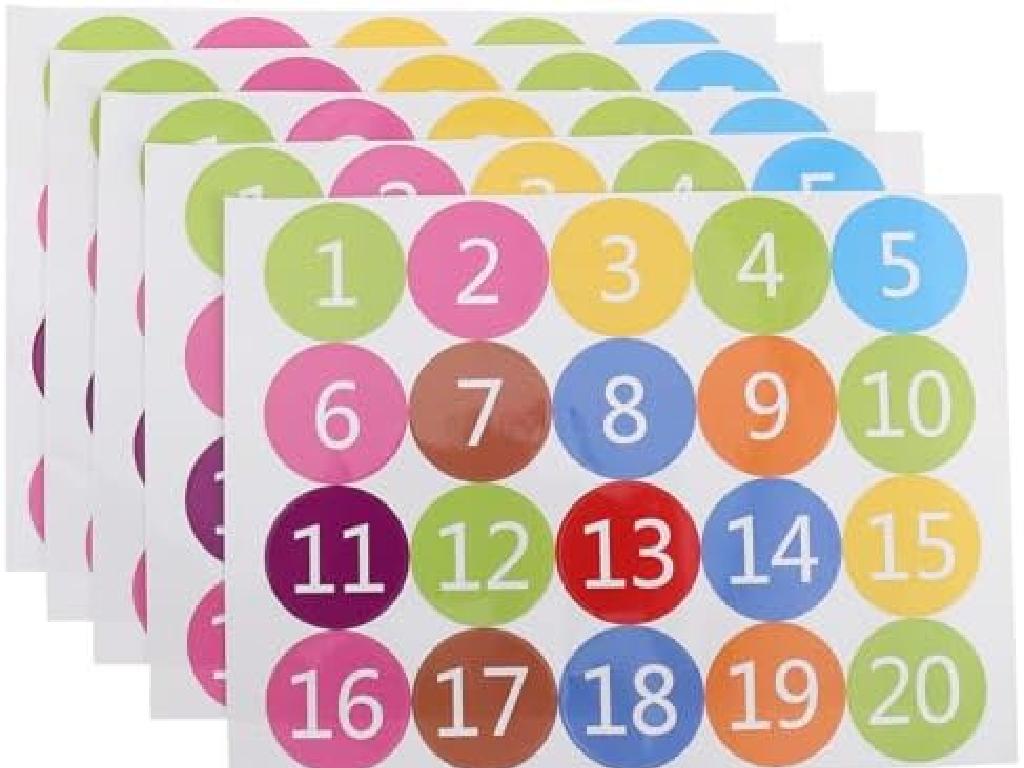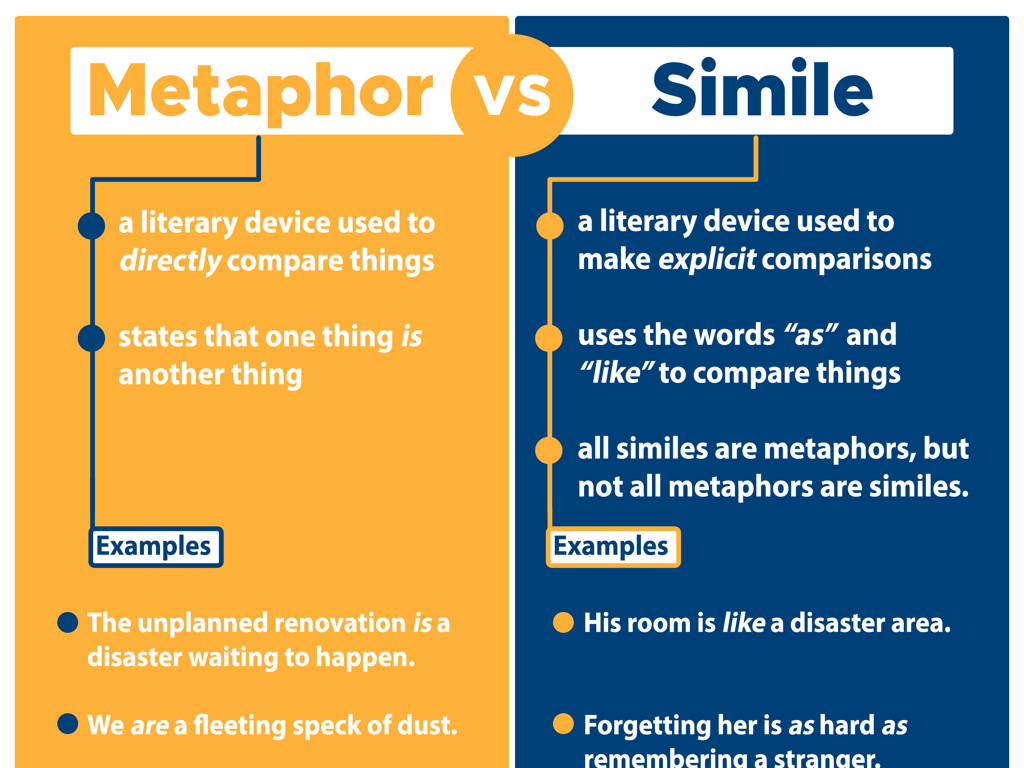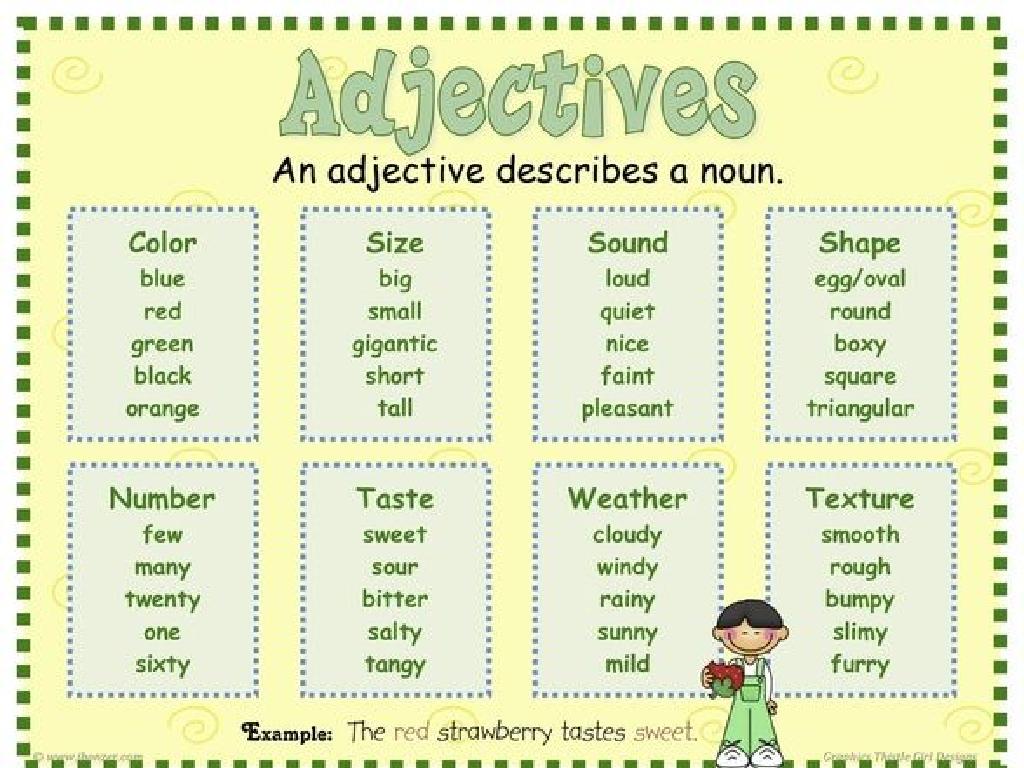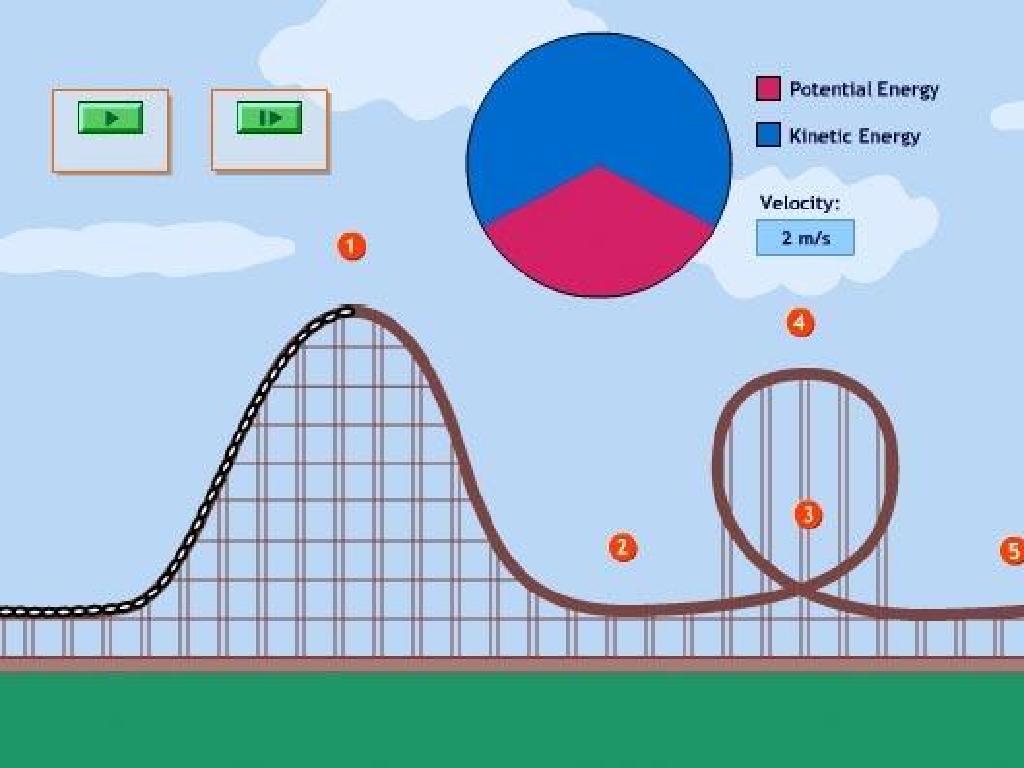Order Adjectives
Subject: Language arts
Grade: Eighth grade
Topic: Adjectives And Adverbs
Please LOG IN to download the presentation. Access is available to registered users only.
View More Content
Order of Adjectives: Enhancing Descriptions
– Adjectives add flavor to sentences
– Correct order makes sentences clear
– For example, ‘a big red ball’ not ‘a red big ball’
– Order of adjectives matters
– It follows a specific sequence like opinion, size, age, shape, color, origin, material, purpose
– Practice ordering adjectives
– We’ll do exercises to master adjective order
|
This slide introduces the concept of the order of adjectives within sentences. It’s crucial for students to understand that adjectives are not just random descriptors but follow a specific order to make sense. The correct sequence of adjectives before a noun can significantly change the clarity of a sentence. For instance, we say ‘a lovely little old rectangular green French silver whittling knife’ because it sounds natural to English speakers. The lesson will involve explaining the standard order of adjectives and why it’s important, followed by practice exercises where students will arrange adjectives in the correct order to enhance sentence clarity. Encourage students to think about adjectives they use daily and how rearranging them might change the meaning or clarity of their sentences.
Exploring Adjectives
– Adjectives describe nouns
– Examples: small, blue, shiny
– ‘Small’ describes size, ‘blue’ color, ‘shiny’ quality
– Activity: Find adjectives in sentences
– Look for descriptive words in a provided sentence
– Understanding adjective order
– Adjectives have a specific order in English
|
Begin with a brief review of adjectives, ensuring students recall that these are words used to describe nouns. Provide clear examples of adjectives, highlighting their variety and how they can describe size, color, and other qualities. For the activity, present sentences and have students identify the adjectives within them. This will help reinforce their understanding of adjectives in context. Lastly, introduce the concept of adjective order, which will be explored in subsequent slides. The activity should be interactive, and students can work individually or in pairs to identify adjectives. Possible sentences for the activity: ‘The old, red car broke down on the busy highway.’ or ‘She wore a beautiful, long, white dress to the concert.’
Understanding Adverbs and Adjectives
– Adverbs typically end in -ly
– They describe how, when, where, or to what extent an action is performed, e.g., ‘She ran quickly.’
– Adjectives modify nouns or pronouns
– They describe a noun or pronoun, e.g., ‘She has a quick mind.’
– Example of adverb in use
– ‘Quickly’ tells us how she ran.
– Example of adjective in use
– ‘Quick’ describes her mind.
|
This slide aims to clarify the difference between adverbs and adjectives for students. Adverbs, often ending in -ly, modify verbs and give more information about the action. Adjectives, on the other hand, are used to describe nouns or pronouns, providing details about objects, people, or concepts. Use the examples provided to illustrate how ‘quickly’ as an adverb modifies the verb ‘ran’, indicating the manner of running, whereas ‘quick’ as an adjective modifies the noun ‘mind’, describing a characteristic of the mind. Encourage students to come up with additional examples and to identify adverbs and adjectives in sentences to reinforce their understanding.
The Order of Adjectives in English
– Adjectives follow a specific order
– General order: Quantity, Opinion, Size, Age, Shape, Color, Origin, Material, Purpose
– Example: ‘Three beautiful large old round blue French wooden serving bowls’
– ‘Three’ (Quantity), ‘beautiful’ (Opinion), ‘large’ (Size), ‘old’ (Age), ’round’ (Shape), ‘blue’ (Color), ‘French’ (Origin), ‘wooden’ (Material), ‘serving’ (Purpose)
– Practice creating your own examples
– Use objects around you to form descriptive phrases
|
This slide introduces students to the standard sequence in which adjectives appear in English sentences. Emphasize the importance of this order as it is commonly used and expected in English communication. Provide the general order and use the example to illustrate how multiple adjectives are used before a noun. Encourage students to practice by looking around the classroom or their homes to find items they can describe using this order. This exercise will help them internalize the pattern and improve their descriptive writing skills.
Why Does Order Matter in Adjectives?
– Natural order appeals to native speakers
– Incorrect order leads to confusion
– Practice rearranging adjectives
– Let’s unscramble adjectives in sentences for clarity
– Understand the importance of order
– Grasping order enhances communication
|
This slide emphasizes the importance of the correct order of adjectives in English. Native speakers intuitively know that adjectives have a natural order, and when adjectives are out of order, sentences can sound awkward or even become unclear. The class activity involves rearranging jumbled adjectives to form coherent sentences. This will help students understand how the order of adjectives can change the meaning or clarity of a sentence. For example, ‘a big old green antique car’ sounds correct, but ‘a green antique old big car’ sounds awkward. Encourage students to listen to the rhythm and flow of sentences with correctly ordered adjectives. Provide additional examples and encourage students to create their own jumbled sentences for peers to rearrange.
Practice Time: Ordering Adjectives
– Exercise: Correct order of adjectives
– Class Activity: Crafting sentences
– Use a given list of adjectives to write creative sentences.
– Share sentences with peers
– Present your sentences to the class for discussion.
– Discuss and provide feedback
– Listen to others and offer constructive criticism.
|
This slide is designed for a class activity focused on the practical application of ordering adjectives. Begin with a brief exercise to remind students of the correct order of adjectives in English. Then, move on to the main activity where students create their own sentences using a provided list of adjectives. Encourage creativity and proper usage of adjective order. After crafting their sentences, students will share them with the class, providing an opportunity for peer learning. Conclude with a discussion where students can give and receive feedback on their sentences. This activity will help reinforce their understanding of adjective order and improve their descriptive writing skills. Possible activities: 1) Students could draw cards with adjectives and nouns to create sentences. 2) Pair students up to write a short story using a set of adjectives. 3) Have a competition for the most imaginative sentence. 4) Create a worksheet with scrambled adjectives for students to put in the correct order. 5) Use a familiar text and have students rewrite sentences with the adjectives in the incorrect order, then correct them.
Let’s Play: Adjective Order Challenge
– Pair up for a word ordering game
– Arrange adjectives in the correct order
– Remember the order: quantity, opinion, size, age, shape, color, origin, material, purpose
– Write sentences using ordered adjectives
– Be imaginative and think of fun, descriptive sentences
– Class discussion of your sentences
|
This interactive game is designed to help students understand the proper order of adjectives in a sentence. Students will work in pairs to reinforce their learning through collaboration. They will use a set of adjectives and arrange them according to the standard sequence: quantity, opinion, size, age, shape, color, origin, material, and purpose. After creating sentences with these ordered adjectives, we will come together as a class to review and discuss each pair’s sentences. This will not only help students learn from each other but also allow them to practice and recognize the importance of adjective order in sentence structure. Encourage creativity and praise students for unique and correctly structured sentences.
Class Activity: Adjective Art Collage
– Create an adjective collage
– Use magazine cutouts to represent adjectives
– Describe using proper adjective order
– Quantity, Value/Opinion, Size, Temperature, Age, Shape, Color, Origin, Material
– Present your collage to the class
– Share and explain the choice of adjectives and their order
|
This activity is designed to help students understand the order of adjectives through a creative and engaging art project. Students will search for images in magazines that represent different adjectives, then create a collage. When describing their collage, they should use the correct sequence of adjectives: quantity, opinion, size, temperature, age, shape, color, origin, and material. This will reinforce their understanding of how adjectives are organized in English. Encourage students to be prepared to explain why they placed adjectives in a particular order. Possible variations of the activity could include creating digital collages, using different themes, or working in groups.
Wrapping Up: Order of Adjectives
– Recap: Order of adjectives
– Homework: Describe your dream bedroom
– Include 10 adjectives in proper sequence
– Use 10 different adjectives
– Upcoming quiz: Adjectives & Adverbs
– Review today’s lesson to prepare
|
As we conclude today’s lesson, remind students of the importance of the correct order of adjectives when describing nouns. For homework, they should write a creative paragraph about their dream bedroom, carefully placing at least 10 different adjectives in the correct order to describe various aspects such as size, color, and material. This exercise will help reinforce their understanding of the concept. Additionally, inform students about the upcoming quiz on adjectives and adverbs to encourage them to review the material covered in class. Provide some study tips and remind them of the resources available to aid their preparation.





